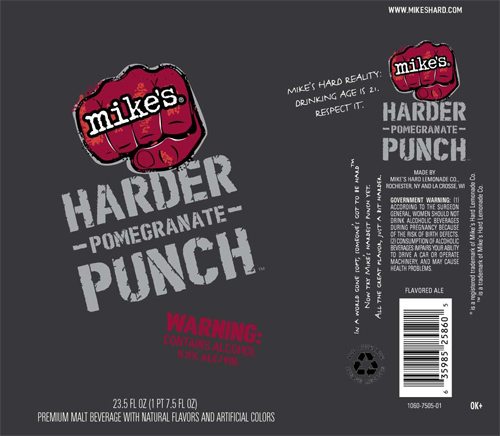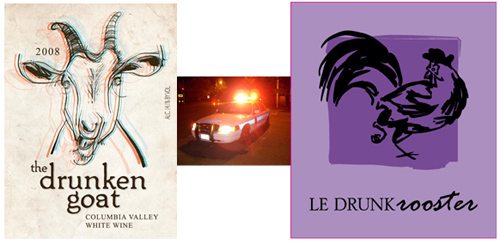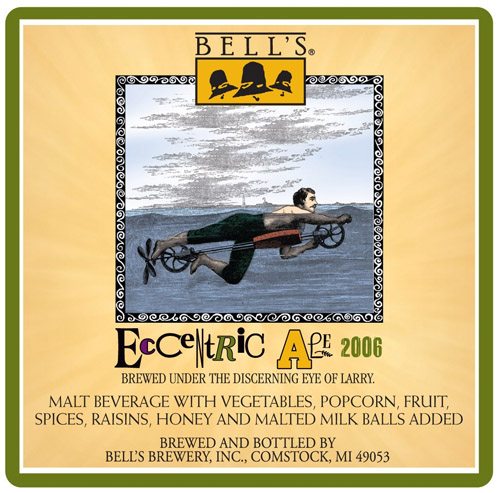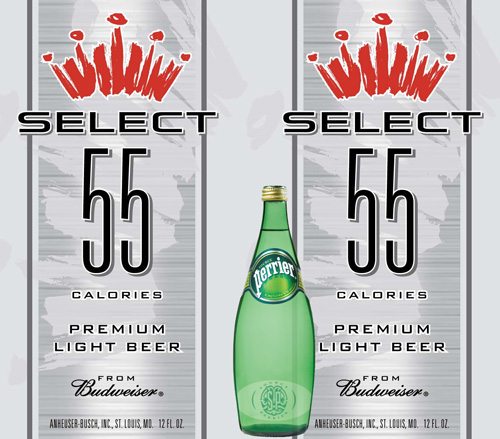It wasn’t so very long ago that TTB would not allow anything like an alcohol content claim, on beer, unless the states required it. The turnabout is quite remarkable, since Coors sued to change the law back in the mid-1990s. Here is a Mike’s Harder Punch label that declares itself to be “hard” no less than seven times in a few square inches, with a couple of fists to drive the point home. It is “Mike’s Hardest Punch Yet.”
Thankfully, the label doesn’t make us guess how hard. It comes right out and explains that it’s 9.9% alc./vol., about double normal beer. The label also sports a “Warning” other than the mandated warning. TTB does not often allow extra warnings (pregnant lady warning) but will do so from time (no kids warning) to time (flammable warning).
Drunken Animals
TTB typically does not allow wine labels to say much about the alcohol content or strength — except in the normal alcohol by volume statement.
So we were surprised that The Drunken Goat, and his n’er-do-well friend, Le Drunk Rooster, would show up on a couple of wine labels. We pretty much expected them to show up, sooner or later, on a spirits label. But not on a wine or beer label, where TTB has historically and fairly vigorously discouraged alcohol content claims.
While the goat and rooster are carousing around, notable is the absence of any drunk humans out and about on approved labels. Unless you count this guy, the toothless fellow on the label for Rocky Mountain Moonshine Sippin’ Hooch. It is distilled from beets and the label suggests “Once tasted, you too will become hooked!” Box 19 surprisingly declares that “The man is no longer ‘drunk’ appearing.” If he’s sober I’d like to see the other version.
Onion Wine
Is it safe to assume wine is made from grapes? Not really. Is it safe to assume wine is made from fruit? Apparently not, as indicated by River Myst’s onion wine. It is fermented from 55% onions, 27% potatoes, and 18% raisins.
Jailhouse is another example of a wine with very little “fruit” and a little bit of raisin. It is 90% honey, 9% orange, 1% raisin, and spices.
P*rt Wine
If you are lucky enough to have a wine approved before 2006, you can call it Port. But if it’s made outside Portugal and you don’t have an approval before 2006, you are out of luck and will have to find another name.
Schatz Farms went so far as to show a “USB port” and call it “USB” when foreclosed from simply calling their Lodi dessert wine “Port.” The label says the US:
signed an im____ant agreement with the European Union to protect ____ugal’s geographical indication of this type of wine. Our Unidentified Secret Brand is therefore no mystery wine. . . .
Kobalt refrained from calling their Napa Valley dessert wine “Port” and instead described it as “wine made in the same ‘old world tradition’ as that of the country to the west of Spain.” Another example is here: Not Starboard.
By contrast, for an example of a California wine “grandfathered” and therefore able to brandish the term Port, there is Portacinco Port. TTB approved it with this qualification:
Approved under the “Grandfather” Provision of the Agreement between the U.S. and the EC on Trade in Wine, by enacting the Tax Relief and Health Care Act of 2006, signed on 12/20/2006.
Beer with Popcorn and Malted Milk Balls
Beer. With. Vegetables. Popcorn. Fruit. Spices. Raisins. Honey. And Malted Milk Balls.
Wow.
Eccentric indeed. If anyone (excluding this joker) drank a whole bottle and lived to tell about it, please confess below.
Miller and Bud Race Yet Again
First there was Miller Lite, at about 96 calories per 12 ounces (back around 1975).
In later years the non-alcoholic malt beverages (or “near beers”) became more common, with leading brands such as Clausthaler and Kaliber at about 80 calories (as per Skilnik).
Now, in the past year, it appears we have a race to the bottom. That is, Miller Genuine Draft 64 came out about a year ago. It is, not surprisingly, 64 calories per 12 ounces (and 2.8% alc./vol.).
Lower and more recent still is Bud Select 55. It is only 55 calories and 2.4% alc./vol.
This is one important trend over the past 34 years. In a future post we will look at a countervailing trend toward very high calorie/alcohol malt beverages.
All of this leads us to wonder, where will this go in the next 34 years? When the Jonas Brothers hit middle age, will they be drinking Bud Exträ Epic Mega Select 11 (down near the lower limits for the legal definition of beer)? Hops flavored Perrier?







